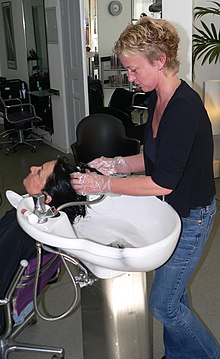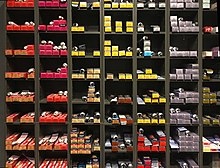Hairdresser
This article needs additional citations for verification. (November 2013) |
The examples and perspective in this article deal primarily with the United States and Canada and do not represent a worldwide view of the subject. (January 2022) |

A hairdresser is a person whose occupation is to cut or style hair in order to change or maintain a person's image. This is achieved using a combination of hair coloring, haircutting, and hair texturing techniques. A hairdresser may also be referred to as a 'barber' or 'hairstylist'.
History
Ancient hairdressing
Hairdressing as an occupation dates back thousands of years. Both Aristophanes and Homer, Greek writers, mention hairdressing in their writings.[1] Many Africans believed that hair is a method to communicate with the Divine Being. It is the highest part of the body and therefore the closest to the divine. Because of this Hairdressers held a prominent role in African communities.[2] The status of hairdressing encouraged many to develop their skills, and close relationships were built between hairdressers and their clients. Hours would be spent washing, combing, oiling, styling and ornamenting their hair. Men would work specifically on men, and women on other women.[verification needed] Before a master hairdresser died, they would give their combs and tools to a chosen successor during a special ceremony.[3]
In
Europe

The first appearance of the word "hairdresser" is in 17th century Europe, and hairdressing was considered a profession.
Women's hair grew taller in style during the 17th century, popularized by the hairdresser Madame Martin. The hairstyle, "the tower," was the trend with wealthy English and American women, who relied on hairdressers to style their hair as tall as possible. Tall piles of curls were pomaded, powdered and decorated with ribbons, flowers, lace, feathers and jewelry. The profession of hairdressing was launched as a genuine profession when Legros de Rumigny was declared the first official hairdresser of the French court. In 1765 de Rumigny published his book Art de la Coiffure des Dames, which discussed hairdressing and included pictures of hairstyles designed by him. The book was a best seller amongst Frenchwomen, and four years later de Rumigny opened a school for hairdressers: Academie de Coiffure. At the school he taught men and women to cut hair and create his special hair designs.[3]
By 1777, approximately 1,200 hairdressers were working in Paris. During this time, barbers formed
19th century

Parisian hairdressers continued to develop influential styles during the early 19th century. Wealthy French women would have their favorite hairdressers style their hair from within their own homes, a trend seen in wealthy international communities. Hairdressing was primarily a service affordable only to those wealthy enough to hire professionals or to pay for servants to care for their hair. In the United States, Marie Laveau was one of the most famous hairdressers of the period. Laveau, located in New Orleans, began working as a hairdresser in the early 1820s, maintaining the hair of wealthy women of the city. She was a voodoo practitioner, called the "Voodoo Queen of New Orleans," and she used her connections to wealthy women to support her religious practice. She provided "help" to women who needed it for money, gifts and other favors.[3]
French hairdresser
20th century
Major advancements in hairdressing tools took place during this period.
Modern hairdressing
Specialties

Some hairstylists specialize in particular services, such as colorists, who specialize in
By country
United States

Occupationally, hairdressing is expected to grow faster than the average for all other occupations, at 20%. A state license is required for hairdressers to practice, with qualifications varying from state to state. Generally a person interested in hairdressing must have a
Occupational health hazards
Like many occupations, hairdressing is associated with potential health hazards stemming from the products workers use on the job as well as the environment they work in.
Formaldehyde
Formaldehyde is a chemical used in various industries and has been classified by the International Agency for Research on Cancer or IARC as “carcinogenic to humans”.[12] The presence of formaldehyde and methylene glycol, a formaldehyde derivative, have been found in hair smoothing products, such as the Brazilian Blowout.[13] The liquid product is applied to the hair, which is then dried using a blow dryer. Simulation studies as well as observational studies of working salons have shown formaldehyde levels in the air that meet and exceed occupational exposure limits.[13][14] Variations in observed levels are a function of ventilation used in the workplace as well as the levels of formaldehyde, and its derivatives, in the product itself.[13][14]
Aromatic amines
Aromatic amines are a broad class of compounds containing an amine group attached to an aromatic ring. IARC has categorized most aromatic amines as known carcinogens. Their use spans several industries including use in pesticides, medications, and industrial dyes.[15] Aromatic amines have also been found in oxidative (permanent) hair dyes; however due to their potential for carcinogenicity, they were removed from most hair dye formulations and their use was completely banned in the European Union.[16]
Phthalates
Health considerations
Reproductive
Most hairdressers are women of childbearing age, which lends to additional considerations for potential workplace exposures and the risks they may pose.[9] There have been studies linking mothers who are hairdressers with adverse birthing outcomes such as low birth weight, preterm delivery, perinatal death, and neonates who are small for gestational age.[9][18][19] However, these studies failed to show a well-defined association between individual risk factors and adverse birthing outcomes. Other studies have also indicated a correlation between professional hairdressing and menstrual dysfunction as well as subfertility.[20][21] However, subsequent studies did not show similar correlations.[22] Due to such inconsistencies, further research is required.
Oncologic
The International Agency for Research on Cancer or IARC, has categorized occupational exposures of hairdressers and barbers to chemical agents found in the workplace as “probably carcinogenic to humans” or category 2A in their classification system.[12] This is due in part to the presence of chemical compounds historically found in hair products that have exhibited mutagenic and carcinogenic effects in animal and in vitro studies.[12] However, the same consistent effects have yet to be fully determined in humans. There have been studies showing a link between occupational exposure to hair dyes and increased risk of bladder in male hairdressers but not females.[12][23] Other malignancies such as ovarian, breast and lung cancers have also been studied in hairdressers, but the outcomes of these studies were either inconclusive due to potential confounding or did not exhibit an increase in risk.[12]
Respiratory
Volatile organic compounds have been shown to be the largest inhalation exposure in hair salons, with the greatest concentrations occurring while mixing hair dyes and with use of hair sprays.[12][24] Other notable respiratory exposures included ethanol, ammonia, and formaldehyde.[12] The concentration of exposure was generally found to be a function of the presence or absence of ventilation in the area in which they were working.[14][24] Studies have exhibited an increased rate of respiratory symptoms experienced such as cough, wheezing, rhinitis, and shortness of breath among hairdressers when compared to other groups.[25][26] Decreased lung function levels on spirometry have also been demonstrated in hairdressers when compared to unexposed reference groups.[25]
Dermal
Contact dermatitis is a common dermatological diagnosis affecting hairdressers.[27][28] Allergen sensitization has been considered the main cause for most cases of contact dermatitis in hairdressers, as products such as hair dyes and bleaches, as well as permanent curling agents contain chemicals that are known sensitizers.[28][29] Hairdressers also spend a significant amount of time engaging in wet work with their hands being directly immersed in water or by handling of wet hair and tools. Overtime, this type of work has also been implicated in increased rate of irritant dermatitis among hairdressers due to damage of the skins natural protective barrier [30]
See also
References
- ^ "Hair care in the 19th century | Loma Linda University Del E. Webb Memorial Library". library.llu.edu. Retrieved 2022-12-20.
- ^ Oshhaa, M. D. (2022-08-04). "African Hairstyles' Social Importance and Spiritual Significance". Africa Facts Zone. Retrieved 2022-12-20.
- ^ ISBN 978-0-313-33145-9. Retrieved 15 September 2011.
- ^ "Definition of HAIRDRESSER". www.merriam-webster.com. Retrieved 2022-11-17.
- ^ Brown-Paynter, R. (1894–1895). "Freaks of Fashion". Atalanta. 8: 163.
- ISBN 978-0-595-52483-9.
- ISBN 978-0-446-51106-3.
- ^ "Barbers, Cosmetologists, and Other Personal Appearance Workers". Occupational Outlook Handbook 2010–11 Edition. Bureau of Labor Statistics. Retrieved September 15, 2011.
- ^ PMID 24328919.
- PMID 19270042.
- ^ Nutrition, Center for Food Safety and Applied (2022-03-02). "FDA Authority Over Cosmetics: How Cosmetics Are Not FDA-Approved, but Are FDA-Regulated". FDA.
- ^ ISSN 0003-2670.
- ^ S2CID 32690589.
- ^ S2CID 197664376.
- ISBN 978-3-527-30673-2, retrieved 2022-04-12
- S2CID 23915716.
- ^ S2CID 21682547.
- PMID 12151607.
- S2CID 13005915.
- PMID 19713029.
- PMID 8495000.
- PMID 17012331.
- PMID 20447989.
- ^ PMID 20195448.
- ^ S2CID 231634447.
- PMID 14635244.
- S2CID 13019391.
- ^ S2CID 5255739.
- PMID 22960813.
- PMID 25028609.
